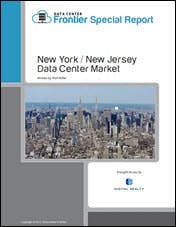The New York data center market has often found itself in recovery mode. Over the last decade, the Manhattan market has been battered by the financial crisis and Superstorm Sandy.
But there are solid signs of a recovery for the Greater New York market, which has been strengthening for several years. The market is about to get new supply, as DataGryd has completed the first phase of MegaSuite 6 at 60 Hudson Street.
The MegaSuite project will add up to 5 megawatts of new capacity on the sixth floor of 60 Hudson Street, the iconic carrier hotel that is a lynchpin of Manhattan’s global connectivity. The 72,000 square foot floor plate is being built out in 1 megawatt rooms, with the ability to customize suites starting at 100 kW and up.
“As one of the largest data center construction projects in Manhattan, MegaSuite 6 stands as the most modern and efficient data center solution in the market,” said Tom Brown, President and CEO of DataGryd. “This underpins our commitment to driving operational efficiencies for customers while delivering the highest possible value into the future.”
Positive Trends for the NY Market
The DataGryd project arrives as the industry is becoming more optimistic about the outlook for Greater New York market.
“The New York metro area has seen a recent resurgence in demand and the market has gradually tightened,” said William Stein, CEO of Digital Realty, one of the larger players in the market. “Excess inventory has been slowly absorbed while new deliveries have been sparse.”
That’s partly due to the rationalization of space and requirements. There’s also hope that New York will benefit from the push to create smarter cities, using sensors and data analysis to bring intelligence to urban environments, and improve the quality of life for residents. The trend brings together the Internet of Things, BigData, artificial intelligence and edge computing to change the way we live and do business in major urban centers.
Data center users in the New York City market typically need to be there for compelling business reasons. The city’s infrastructure for connectivity, especially in Manhattan, is world class due to the data requirements of the area’s large companies.
The New York market had about 3.6 megawatts of space absorbed in 2018, according to Robert Meyers, a Senior Vice President for the CBRE Data Center Solutions Group, who discussed the market at the DCD Enterprise New York event earlier this year. That’s less leasing than seen in many wholesale data center markets, and reflects New York’s status as a destination for premium retail colocation and interconnection space.
“New York is a connectivity-centric market,” said Meyers. “You have a critical mass of connectivity here, starting at 60 Hudson Street and spreading outward. The deployments have gotten smaller in the tri-State area.”
Matching Rooms to Smaller Requirements
DataGryd has also embraced those shifting requirements in its design of MegaSuite 6.
“We made a conscious decision that the market has changed,” CEO Brown told DCF earlier this year. “You don’t see opportunities to sell a half-floor or a full floor. The requirements we are seeing are 100 kw to 500 kw, with some 1 to 2 megawatt customers.”
DataGryd was founded in 2012 to provide wholesale data center space in the heart of New York, operating from vacant space on several floors at 60 Hudson, a 23-story art-deco building in the city’s TriBeCa section. The company landed an anchor tenant in Telx (now part of Digital Realty), the primary interconnection provider in the building, which leased the entire fifth floor in 2014.
DataGryd is not alone in expanding its infrastructure in the region. Interconnection specialist DE-CIX New York said that orders for 100 Gigabit Ethernet ports increased by 70 percent in 2018, prompting it to add 100 GE capabilities on three of its data centers in Greater New York: 325 Hudson Street and 85 10th Avenue in Manhattan, and 2 Emerson Lane in Secaucus, New Jersey.
Other industry players with substantial footprint in Manhattan include Digital Realty, CoreSite, Sabey Data Centers, Telehouse, Internap, Atlantic Metro, NYI, vXchange and zColo.
New York’s Selling Points: Connectivity and Eyeballs
New York City has been an early adopter of many security-related IoT technologies (security cameras, license plate scanners) as part of its post 9-11 focus on homeland security. More broadly, the IoT is bringing intelligence to everything from trash cans to park benches to dedicated ad-supported wifi kiosks like the LinkNYC or CIVIQ SmartScapes.
Download the DCF New York/New Jersey Market Report.
Users find the NYC data center market attractive for several reasons:
- Strategic Location — Data center users often choose the NYC market because of its strategic proximity to large businesses.
- Robust Connectivity — New York City’s telecommunications infrastructure, specifically the transatlantic cables enabling faster international connectivity, is an advantage to users with those needs.
America’s largest city is a top market for data centers. While New York City’s high cost of doing business often deters providers, some companies require a data center located in the city. Almost all data centers in the New York City (NYC) market are concentrated in Manhattan, with most providers operating in retrofitted high-rise towers.
Data center demand in New York is dominated by the presence of the financial industry, which employs 330,000 in New York and accounts for more than 39 percent of the city’s economic output. Data center and IT infrastructure is critical to the operations of the city’s financial industry, tracking securities trading and storing transaction data.
The most compelling reason for companies to place data center operations in New York is the sheer size of the audience.
“You have eyeballs here, and eyeballs always win over time,” said STACK Infrastructure CEO Brian Cox at DCD Enterprise. “People like to be proximate to their servers. Where New York will continue to win is eyeballs, eyeballs, eyeballs.”







